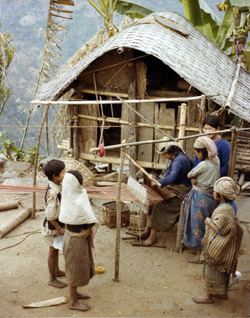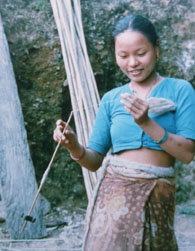Life in the Koshi Hills of Nepal
The major centre for the allo production in the Koshi hills is Sankhuwasabha about 4 days hard walk from Dhankuta. Most families possess no more than a quarter or a half hectare of land where maize, millet and some potatoes and beans and a few other vegetables are grown. Only a few own sheep. The average size of the family is five. The land can not support the family throughout the year. When food supply runs low some money is earned by portering or by selling allo products, wool or livestock.
The Rai are descendants of the ancient Kiratis, the indigenous people of Nepal.
They have a strong tradition of weaving on backstrap looms in the winter months when no fieldwork needs to be done. They spin the yarn on hand spindles sitting or often while walking the 3-4 day hard journey to the market towns or while looking after the animals in the field. The men make the looms and the women weave at or near their homes. It takes 5 days to weave one big sack on a backstrap loom.
The process of harvesting and preparing the allo is slow and laborious:
The stinging 'thorns' on both stem and leaves of the allo plant make cutting the stems rather hazardous, exacerbated by the many leeches present during the wet season. The hands are protected by a bundle of cloth which is used for rubbing off the leaves and 'thorns'.
The bark is then separated and stripped from the stem using the teeth before overnight boiling. The next day the bark is rinsed, beaten and rubbed with clay soil to make separating the fibres and spinning easier. The strands of fibres are then dried by hanging in the sun.
Ref . "The Nettle in Nepal a cottage industry" by Susi Dunsmore ISBN 0 86182 008 8



